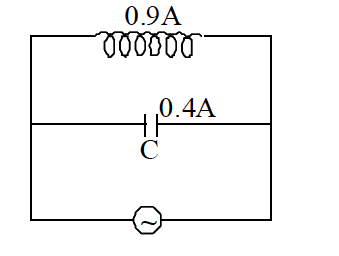Statement-I: At resonance. LCR circuit have a minimum current.
Statement-II: At resonance, in LCR circuit, the current and e.m.f are in phase with each other.
If both Statement- I and Statement- II are true, and Statement - II is the correct explanation of Statement– I.
If both Statement - I and Statement-II are true but Statement - II is not the correct explanation of Statement – I.
If Statement-I is true but Statement-II is false.
If Statement-I is false but Statement-II is true.
The correct Answer is:D
To analyze the statements provided in the question regarding the LCR circuit at resonance, let's break down the solution step by step.
1. Understanding the LCR Circuit:
- An LCR circuit consists of an inductor (L), a capacitor (C), and a resistor (R) connected in series. The behavior of this circuit is influenced by the frequency of the alternating current (AC) supplied to it.
Hint: Remember that the LCR circuit's behavior is defined by the relationship between inductive reactance (XL), capacitive reactance (XC), and resistance (R).
2. Resonance Condition:
- The resonance condition in an LCR circuit occurs when the inductive reactance (XL) equals the capacitive reactance (XC). Mathematically, this is expressed as:
XL=XC
- At this point, the circuit is said to be at resonance.
Hint: Recall that at resonance, the reactances cancel each other out, leading to a simplified analysis of the circuit.
3. Impedance at Resonance:
- The total impedance (Z) of the circuit is given by:
Z=√(XL−XC)2+R2
- When XL = XC, the equation simplifies to:
Z=R
- This indicates that the impedance is at its minimum value, which is equal to the resistance R.
Hint: Impedance is crucial in determining the current in the circuit; lower impedance means higher current.
4. Current Calculation:
- The current (I) in the circuit can be calculated using Ohm's law for AC circuits:
I=E0Z
- Substituting Z with R (at resonance):
I=E0R
- This shows that at resonance, the current is maximized because Z is minimized.
Hint: Think about how current behaves in relation to impedance; lower impedance leads to higher current.
5. Analysis of Statements:
- Statement I: "At resonance, LCR circuit have a minimum current."
- This statement is false because the current is actually at its maximum at resonance.
- Statement II: "At resonance, in LCR circuit, the current and e.m.f are in phase with each other."
- This statement is true because at resonance, the circuit behaves like a purely resistive circuit, where voltage and current are in phase.
Hint: Evaluate each statement based on the definitions and relationships established in the analysis.
6. Conclusion:
- Based on the analysis, the correct answer is that Statement I is false and Statement II is true.
Final Answer:
- Statement I: False
- Statement II: True
- An LCR circuit consists of an inductor (L), a capacitor (C), and a resistor (R) connected in series. The behavior of this circuit is influenced by the frequency of the alternating current (AC) supplied to it.
- The resonance condition in an LCR circuit occurs when the inductive reactance (XL) equals the capacitive reactance (XC). Mathematically, this is expressed as:
XL=XC
- At this point, the circuit is said to be at resonance.
- The total impedance (Z) of the circuit is given by:
Z=√(XL−XC)2+R2
- When XL = XC, the equation simplifies to:
Z=R
- This indicates that the impedance is at its minimum value, which is equal to the resistance R.
- The current (I) in the circuit can be calculated using Ohm's law for AC circuits:
I=E0Z
- Substituting Z with R (at resonance):
I=E0R
- This shows that at resonance, the current is maximized because Z is minimized.
- Statement I: "At resonance, LCR circuit have a minimum current."
- This statement is false because the current is actually at its maximum at resonance.
- Statement II: "At resonance, in LCR circuit, the current and e.m.f are in phase with each other."
- This statement is true because at resonance, the circuit behaves like a purely resistive circuit, where voltage and current are in phase.
- Based on the analysis, the correct answer is that Statement I is false and Statement II is true.
- Statement I: False
- Statement II: True
Similar Questions
Knowledge Check
- Question 1 - Select One
Assertion : At resonance, LCR series circuit have a minimum current.
Reason : At resonance, in LCR series circuit, the current and e.m.f. are not in phase with each other.AIf both assertion and reason are true and reason is the correct explanation of assertion.BIf both assertion and reason are true but reason is not the correct explanation of assertion.CIf assertion is true but reason is false.DIf both assertion and reason are false. - Question 2 - Select One
In an LCR series circuit the current is
Ain phase with applied emfBlags the applied voltageClead the applied voltageDmay lead or lag behind the applied voltage - Question 3 - Select One
In LCR series AC circuit, the current
Ais always in phase with voltageBalways lags behind the generator voltageCalways leads the generator voltageDmay be in phase, lag behind or lead by the generator voltage depending on the values of L,C and R


